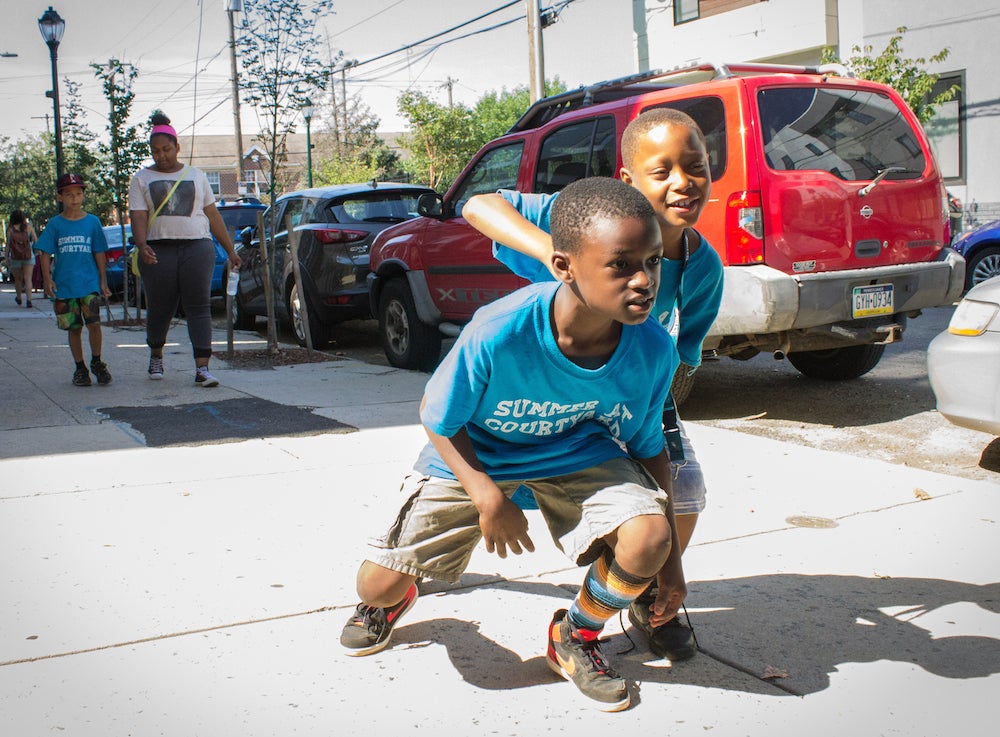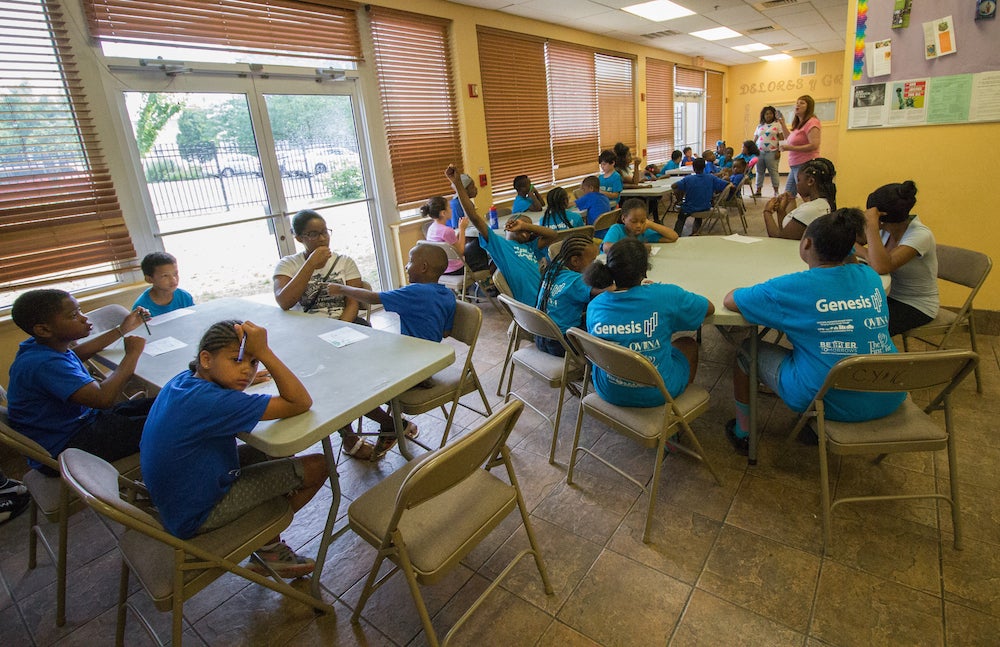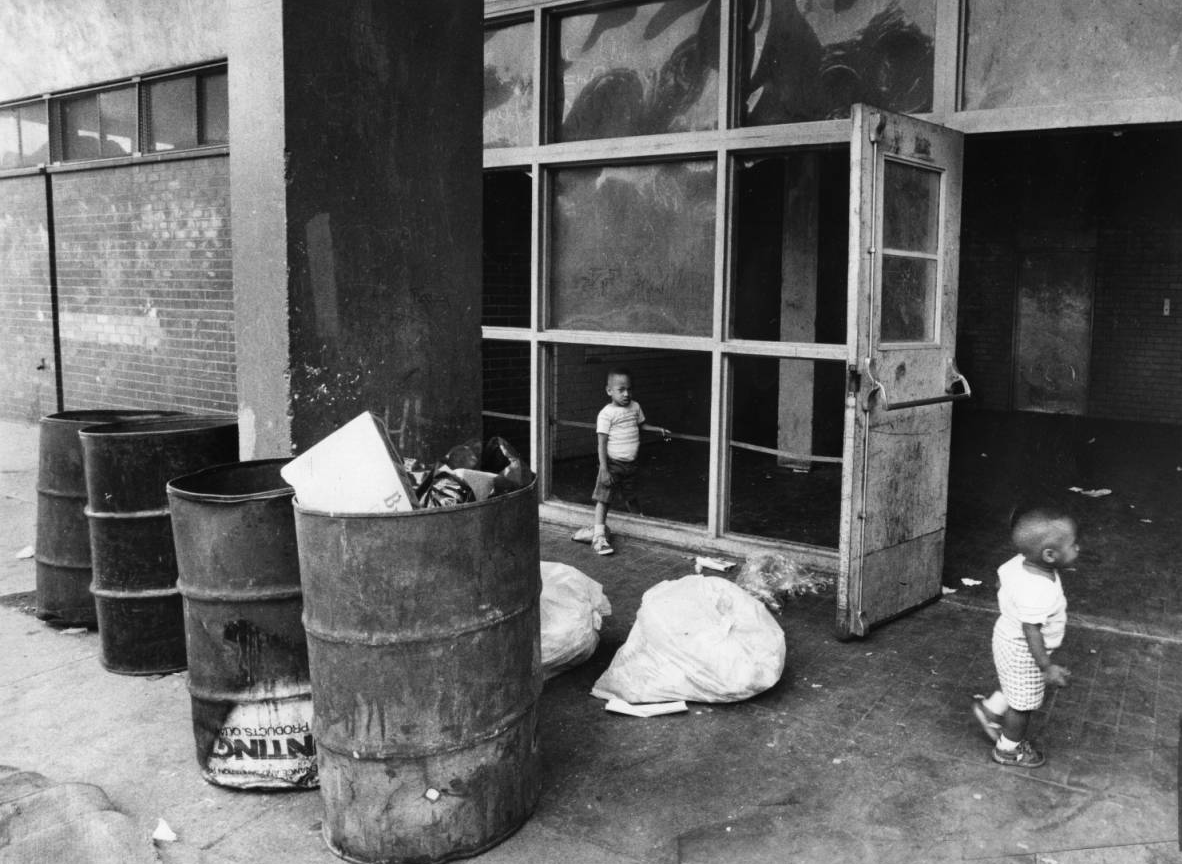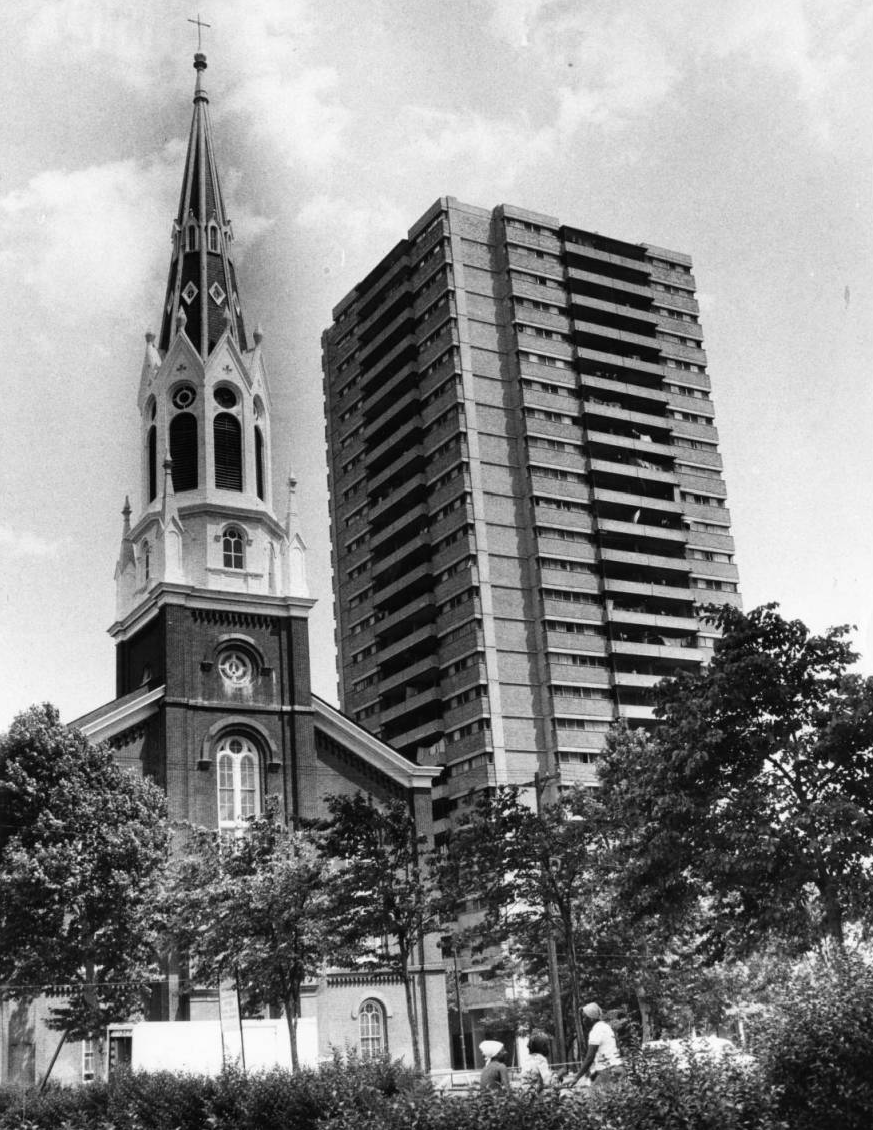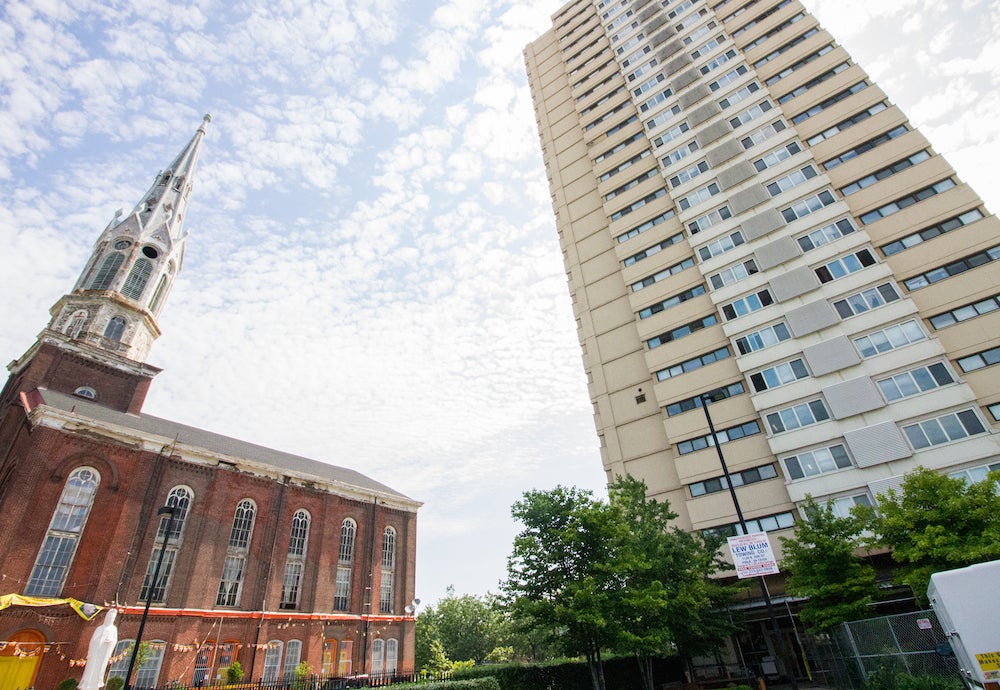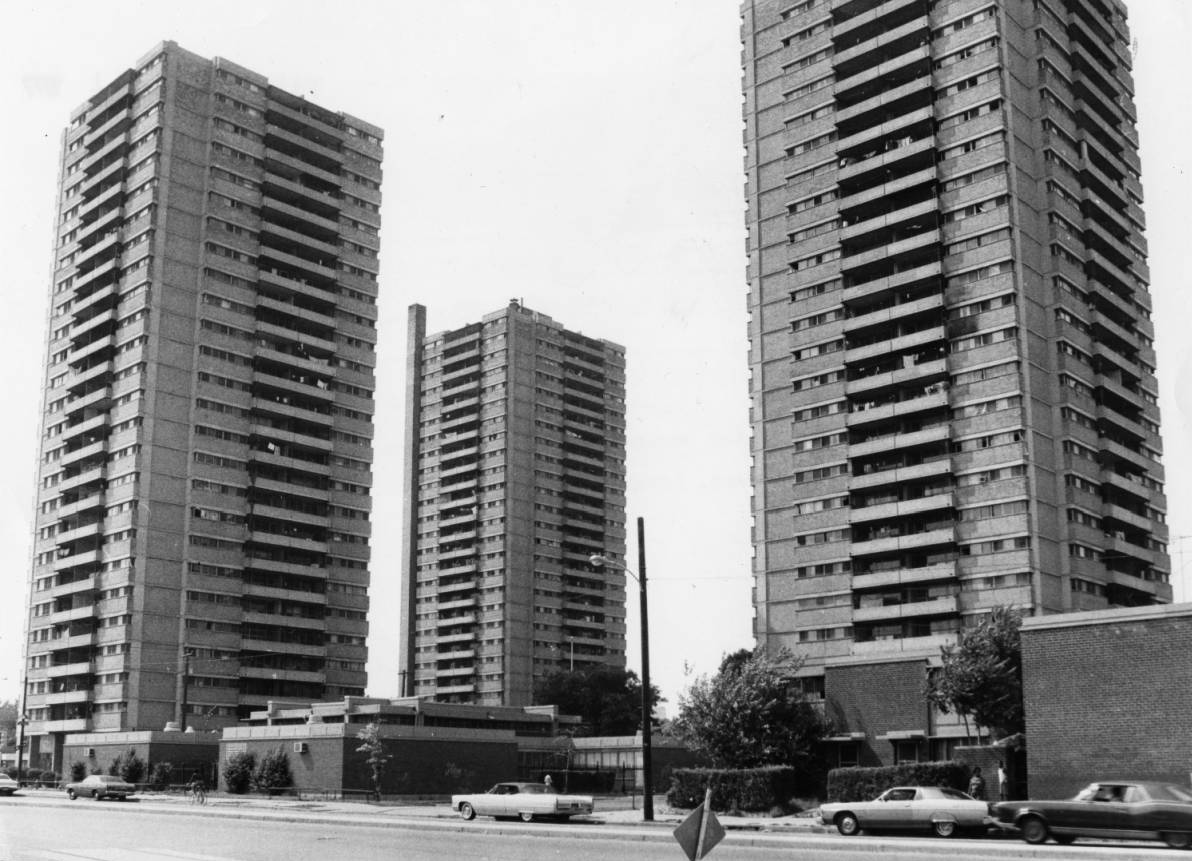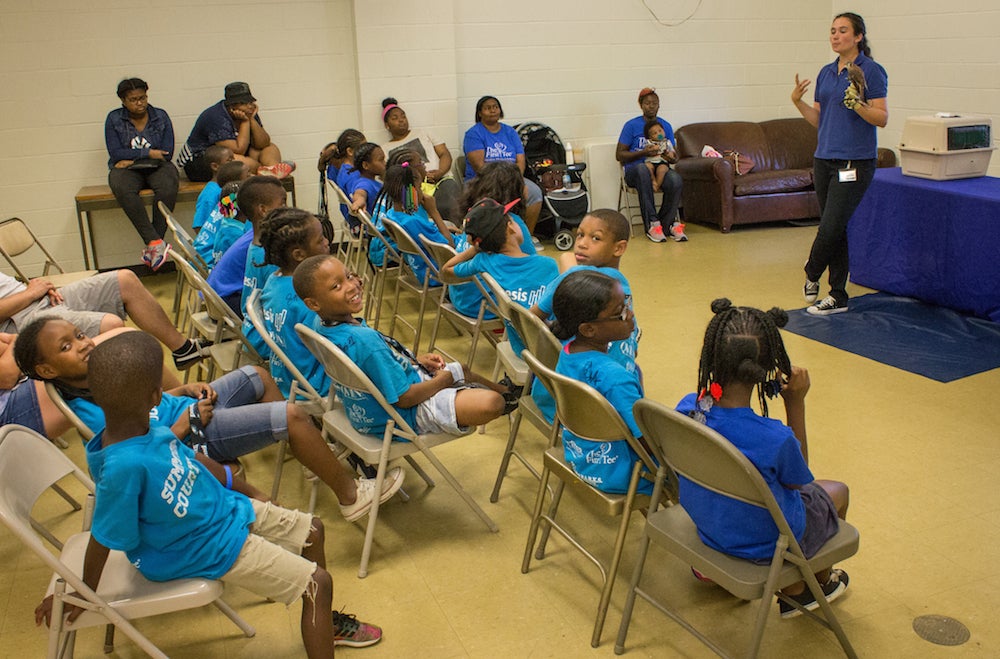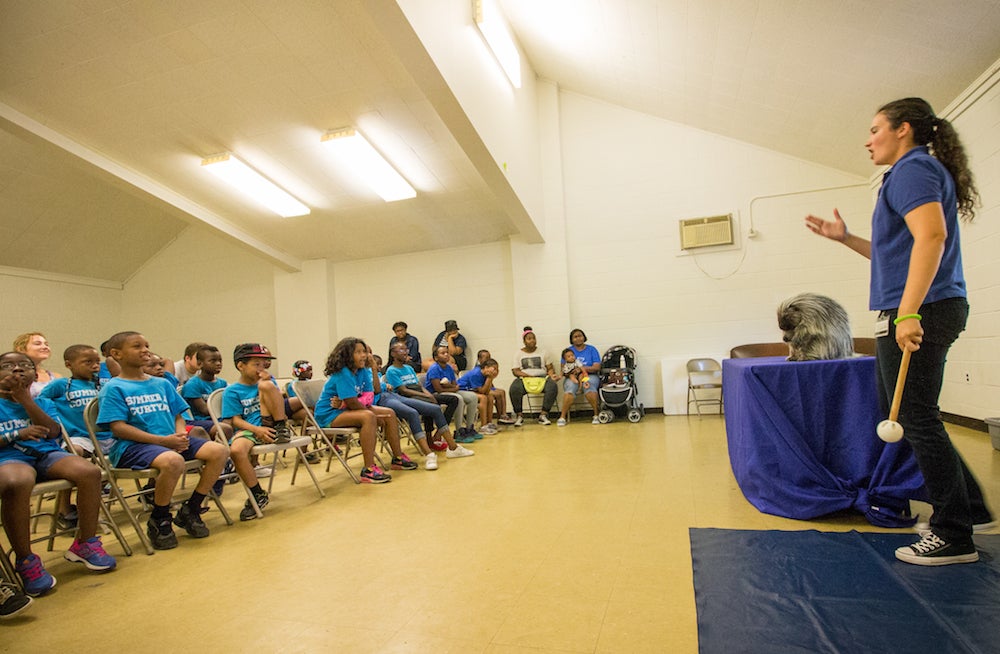Queen Villagers work toward neighborhood integration by organizing around kids
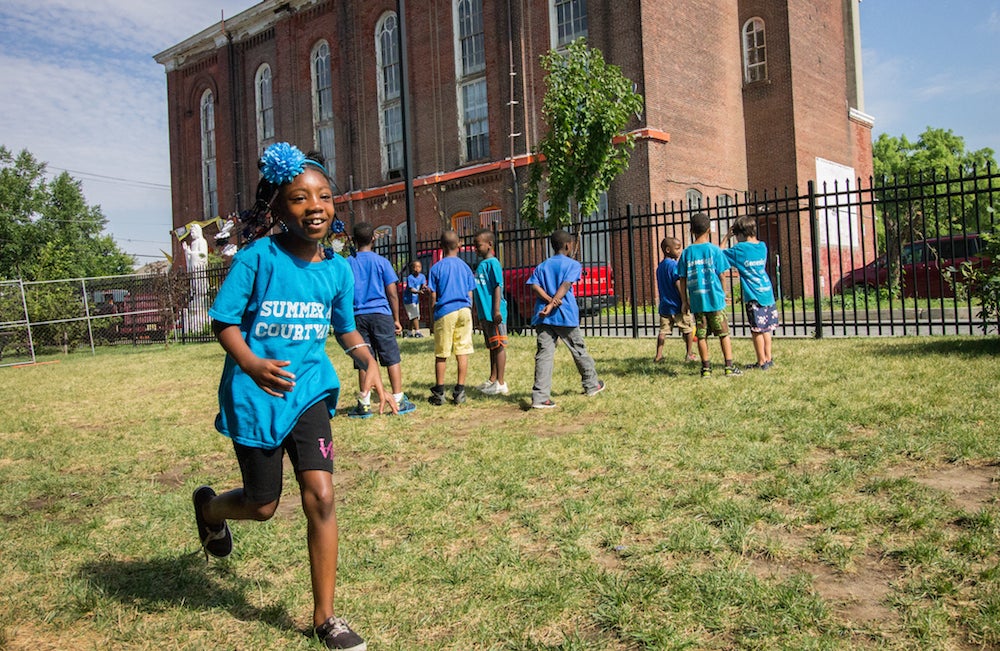
In Queen Village there’s a rare attempt to bridge community divides between affluent residents and tenants of an affordable housing complex through summer programs for neighborhood kids, support for public schools, and representation on the civic association. Is it working? Jake Blumgart checks in on the process of building a more inclusive Queen Village.
Lorenzo Vleze and his friend Thaij Means are peering out the window of a yellow school bus idling at Washington Avenue and 5th Street in South Philadelphia, and demanding attention be paid to the modest brick development outside the window.
“That’s my house right there, that’s my house right there!” yells Means.
Satisfied that the adults have paid homage, he turns his attention to narrating the next leg of the journey to FDR Park, where the bus will deposit the two boys and 26 other children to whack golf balls and play skeeball for the next four hours.
The program sponsoring this venture is “Summer at the Courtyard,” a co-production of the Queen Village Neighbors Association (QVNA) and the Courtyard Apartments’ Resident Council. It’s basically a free summer camp for kids five to twelve—although for legal reasons it’s called an enrichment program—and was originally only open to children who live in the Courtyard Apartments, the permanently affordable housing complex Means enthused about out the bus window.
The great majority of the program’s participants still live in the brick low-rise apartments, which were erected in 2000 to replace the badly deteriorated Southwark Plaza public housing development. But this year, as QVNA devotes more resources to Summer at the Courtyard, the scope of the program has expanded considerably and any child from the wider Queen Village neighborhood is allowed to participate.
For kids like Lorenzo Vleze, a resident of the Courtyard, the program is a welcome opportunity for summer engagement.
“I like that every day we have a trip and that Tuesday and Wednesday we get to ride the bus two times,” says Vleze. “I always like going [to the park] together, so I’m not by myself.”
Asked if he’s made new friends, he assents enthusiastically and starts pointing them out. There’s Max, for instance, sitting right next to him, who lives in the surrounding neighborhood. Then Vleze ticks off the other kids in eyesight who he’s met and befriended, most of whom are also Courtyard kids. It’s been a very good summer. “When I’m not at the camp, I’m bored, so I just like watch TV or do something else,” says Vleze.
Unlike New York City, where public housing complexes can be found in affluent and gentrifying neighborhoods like the Upper West Side and Williamsburg, most of Philadelphia’s permanently affordable housing stock is based in predominantly low-income neighborhoods. But the Courtyard Apartments are located in Queen Village, a long-ago gentrified area that is very much part of the revitalizing core of the city. Unlike many low-income renters, residents of the Courtyard do not have to fear displacement due to increasing housing costs.
In New York researchers have found that merely being close to affluence didn’t provide as great a boon as they had hoped. Public housing residents reported feeling isolated in their remade neighborhoods, both socially and economically. Often their children were hived off into separate public school catchments from more affluent residents.
The Courtyard Apartments complex is not public housing in the strictest sense–some of the units are funded by tax credits that allow for higher income residents, and a private company manages the building–but the great majority of tenants earn 30 percent of the area median income or less. And there is still a divide between them and the six-figure income households that surround them.
Working with QVNA members and other representatives of the larger community, tenant leaders are trying to build bridges to the surrounding neighborhood.
The Courtyard Apartments Resident Council president, Inez “Kandi” Green, recently joined the board of QVNA, a middle class-dominated neighborhood association, whose members have been attempting to strengthen the once-struggling local public school that serves the Courtyard. Now in its second year, Summer at the Courtyard is the most visible manifestation of the halting, sometimes awkward, process of integrating this low-income community into the wider, more affluent neighborhood.
“The first year of unity with Queen Village and the Courtyard was awesome,” says Green of the summer program. “But this year we have diversity and that’s the goal that I’ve been trying to reach. I want the kids to know that these is your neighbors. And I want those kids to know that we are their neighbors. And we should all come together as one and just have fun together.”
The whole situation is highly unusual, maybe even unique in Philadelphia, according to Rasheedah Phillips, Managing Attorney of Community Legal Services’ Housing Unit, which represents subsidized tenants across the city (including Courtyard residents).
“It’s particularly well organized in comparison with a lot of other sites we’ve been involved in. They have a formal system of how things get done, they have the summer camp, they have lots of things that aren’t coming from management,” she says.
The community-driven attempts to bridge neighborhood divides also seem uncommon nationally, says Amy Khare, a researcher with the National Initiative on Mixed-Income Communities at Case Western Reserve University. “Tenant and neighborhood associations co-partnering and building relationships that allow for shared programming could lead to a greater sense of connection. But to be honest, I think that’s pretty rare. I just am not familiar with that occurring at scale or in ways that are not facilitated.”
It wasn’t always like this, however. The public housing complex that became the Courtyard Apartments was opened in 1963 as Southwark Plaza, with 866 units in three high-rise buildings and a smattering of townhomes. Designed by emigre Modernist architect Oscar Stonorov, who had worked on numerous low-income housing complexes throughout the city, it was initially seen as an improvement for a neighborhood blighted by redlining, divestment, and vacancy. But the towers were undermined from the beginning by orders to “use the cheapest material possible” and by the rising tide of crime. Its troubled final years were featured prominently in Buzz Bissinger’s 1997 book, A Prayer For the City, where it is denounced as “casting a potentially fatal effect not only on those who were sentenced to live there but also on those who lived anywhere close to them.”
Prior to its demolition in 2000, the complex suffered from severely deteriorated infrastructure. Incinerators would clog frequently and spew foul smoke into the apartments, elevators worked only intermittently, and at least one of the towers experienced an infestation of black rat snakes. In his book, Bissinger condemns the crime associated with Southwark Plaza for driving one of his middle-class white subjects to the suburbs.
That’s not how Green, who moved to Southwark Plaza in 1985, remembers the complex. Crime was bad back then, and the buildings decaying, but it’s where she raised her son. She fondly recalls sitting on her balcony and looking over the city. When two of the towers were demolished, Green saved a brick from her building as a memento.
Green joined the Resident Council in the early 2000s, soon after Southwark Plaza was destroyed in form and name and the Courtyard was erected in its stead. (Two of the towers were only replaced with townhouses, losing almost 400 units in the transition, with the last tower converted to senior housing. The new complex only contains 470 homes.) She still recalls how isolated the tenants were from the surrounding neighborhood back then.
“It was all separated,” says Green. “Queen Village was with Queen Village and they didn’t even consider Southwark Queen Village at that time.”
As the official representatives of that larger neighborhood, QVNA preserved that distinction until Philadelphia’s education crisis intervened. William M. Meredith Elementary School—where 18.4 percent of students received free or reduced price lunches in the 2011-2012 school year—weathered the crisis well, raising over $15,000 from parents in one night to help offset the cuts. Five blocks away, George W. Nebinger Elementary School—where 85.9 percent of students received lunch aid, and where children who live at the Courtyard are sent—was placed on the list of schools considered for closure.
In 2011, a slate of candidates won election to the board of the QVNA with a promise to aid the ailing neighborhood school. After realizing that an estimated 40 percent of Nebinger’s students came from the Courtyard, the neighborhood association began reaching out to the Courtyard Apartments Resident Council. The two groups began holding meetings in the housing development’s community room.
It was during those meetings that QVNA’s then-president Jeff Hornstein and his fellow board members noticed that the Courtyard’s kids didn’t have much to do during the summer. There was a longstanding program on Mondays at the Southwark/Queen Village Community Garden, but little else throughout the long, hot summer days. The need was noted, but Summer at the Courtyard only really took off last year when Eleanor Ingersoll, now the QVNA executive vice president, took over the programming.
Ingersoll moved into Queen Village in 1999 and became an active volunteer in the public schools long before joining the neighborhood association. Although her three children go to Meredith, she began volunteering at Nebinger too, after the closure scare.
“We realized Meredith had this pretty amazing fundraising base, but I looked over to Nebinger and realized it needed help as well,” says Ingersoll. “It was a natural extension… to work for more inclusion in the entire community.”
Ingersoll rallied $4,000 from QVNA and $3,000 from Genesis Healthcare System to help expand the summer program from one day to three days in 2015, then to four days every week through mid-August this summer. Using these donations, the camp rents a bus twice a week to ferry the kids to FDR Park where they learn how to play golf with the non-profit First Tee (which provides its services to the kids free of charge). On Mondays they do science experiments, on Thursdays art and then head to Shot Tower Recreation Center with its gymnasium and spray ground. Meals are provided free of charge by the Archdiocese, while the company that manages the Courtyard provides additional support and supplies.
This year Summer at the Courtyard has 38 children enrolled and a waiting list. Although most of the kids are from the Courtyard Apartments, several have signed on from elsewhere in the surrounding neighborhoods. Other kids come just for breakfast or lunch, which are open to any child regardless of program enrollment. Both Green and Ingersoll hope the inclusion of those from outside the subsidized housing complex will chip away at the neighborhood barriers before the kids even know they exist.
It’s not always an easy process. The connection between the Courtyard Apartments and the rest of Queen Village is in its nascent stages, with Green and another leader from the housing complex joining the QVNA board last November. It remains to be seen how deep the commitment will run beyond this handful of devoted individuals.
The northern border of Courtyard Apartments on Christian Street still feels like a hard boundary, with the increasing affluence of Queen Village a world apart. Aside from a Chinese takeout and a couple bodegas, 1960s redevelopment erased the commercial character of the street; the parking lots and residential buildings that replaced it don’t do much to integrate Christian Street. But here too are rare exceptions: The Southwark/Queen Village Community Garden and Settlement Music School are both long-standing portals in the wall between the two communities. The census tract that encompasses the housing complex enjoys less than half the median income of its neighbor to the north. At the same time, the black population of Queen Village and even the Courtyard’s own Census tract has been steadily falling since 1980. The new businesses opening in the neighborhood are not the kind that tends to generate jobs for the residents.
“It used to just be South Street and Fabric Row but you see more coming inside the community now, which is good,” says Green. “I don’t think they do [employ Courtyard residents], because it’s just mom and pop, pop up cafes and little stuff like that. Nothing big jobs oriented.”
Beyond the summer program, however, the Courtyard benefits from the increasing affluence of Queen Village in two other measurable ways. In comparison with 1998, the first year of accurate police mapping, the 2015 major crime numbers for Queen Village as a whole are 37 percent lower and they are over 30 percent lower in the blocks comprising the Courtyard Apartments. The longstanding Friends of Nebinger group, meanwhile, has been attracting a lot of newcomers from Queen Village and raised roughly $50,000 over the last three years.
“I want to ultimately see more partnerships between Meredith and Nebinger,” says Ingersoll. “Everyone screams and cries and kvetches about our overcrowded classrooms at Meredith—‘What are we going to do?’ You know what you do? You help Nebinger and you make two awesome schools.”
Nebinger is already beginning to change. The principal, Anh Brown, says 400 students will be enrolled in the fall (a 37.5 percent increase since 2011). When she took over in 2013, Brown began hosting open houses for local residents in a bid to show parents that their neighborhood school is a safe, feasible choice and they needn’t go charter or private—or to the suburbs.
“My upper grades are predominantly Latinos, Asians, and African Americans, but my lower grades are actually more diverse groups,” says Brown. “The affluent population got involved in the school. Eventually the school will be a complete integration of very different cultures.”
In an area without a bastion of permanently affordable housing, it is possible Brown’s vision could be eroded from the higher end of the income spectrum, turning Nebinger into the preserve of the children of affluent families. But the Courtyard Apartments’ affordability will remain protected by federal housing rules for the foreseeable future. And kids like Lorenzo and Thaij will have a chance to participate not only in summer programming, but in an improved elementary school as well.
Sitting in the community room at the end of a long day, as the kids from the Courtyard eat water ice contentedly around her, Ingersoll remembers the people who lived on her block of little, affordable trinity houses when she moved to Queen Village in 1999. She spent the next few years watching her neighbors, old-timers with limited means, move out and be replaced by middle class people like her.
“Those houses used to be strictly for renting to those people. I was part of the change,” Ingersoll says. But she doesn’t have to worry about the families from Courtyard suffering a similar fate.
This piece was produced in collaboration with Hidden City. Text by Jake Blumgart for PlanPhilly, photography by Michael Bixler for Hidden City.
WHYY is your source for fact-based, in-depth journalism and information. As a nonprofit organization, we rely on financial support from readers like you. Please give today.



